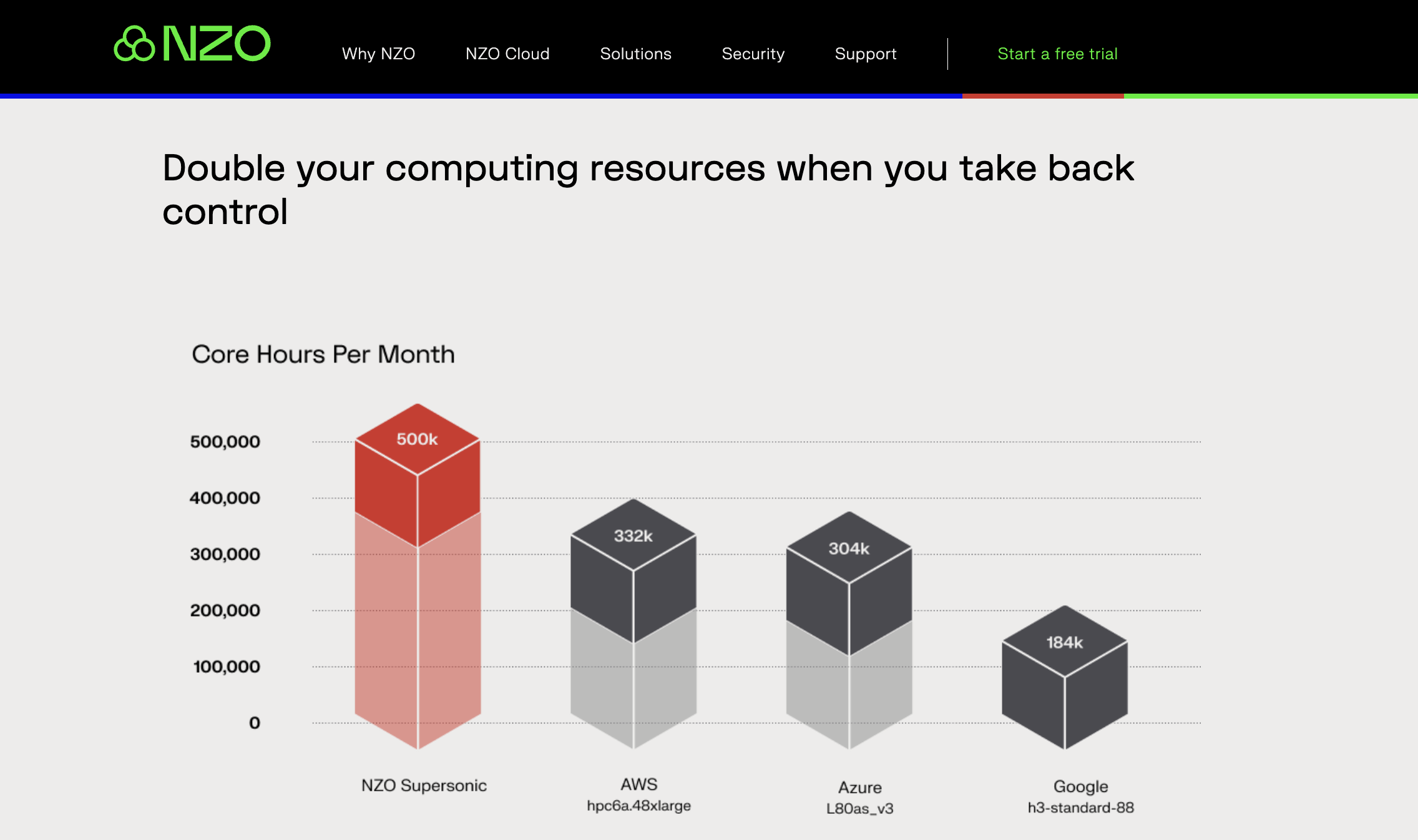Table of Contents

As our technical demands get higher, the need for more robust computing power becomes necessary. In the past, analyzing vast amounts of data took an astonishing amount of resources and power, not to mention a lot of time. High performance computing systems can analyze data and perform calculations in mere seconds—calculations and analytics that would take humans days, weeks, months, or even years to complete. As technologies like the Internet of Things (IoT), artificial intelligence (AI), and more become more commonly used in business and for entertainment, the demand for the computational power to be able to process vast amounts of data quickly will only increase.
The quintessential example of high computing performance for decades has been the supercomputer. Although these behemoth machines are still used (the fastest supercomputer is the US-based Frontier, a computer with a processing speed of 1.102 exaflops, or quintillion floating point operations per second. But through cloud-based high performance computing, organizations can now access exceptional computational power via the cloud from vendors with HPC solutions on high-speed computer servers.
High performance computing (HPC) is a game-changing solution that revolutionizes how we process and analyze data. From scientific research and industrial simulations to weather forecasting and artificial intelligence, high performance technical computing plays a crucial role in various fields. This comprehensive guide will delve into the world of high performance computing, exploring its definition, importance, architecture, components, benefits, use cases, and the challenges faced in its implementation.
What is High Performance Computing (HPC)?
High Performance Computing (HPC) refers to the use of supercomputers or computer clusters to perform advanced computations at a significantly higher speed and efficiency than traditional computers. These computing systems leverage parallel processing, where multiple tasks are executed simultaneously, to achieve remarkable performance levels. HPC has become indispensable in tackling complex problems and handling massive amounts of data that would be impossible to process using conventional computing methods.
One of the key characteristics of high performance technical computing is its ability to solve complex scientific and engineering problems that require intensive calculations. Here are some examples of how this works:
- In weather forecasting, HPC simulates and predicts weather patterns by processing vast amounts of atmospheric data in a fraction of the time it would take traditional computers. This has revolutionized the accuracy and timeliness of weather forecasts, enabling better preparedness for severe weather events.
- In drug discovery, HPC is utilized to screen millions of chemical compounds to identify potential drug candidates, significantly accelerating the drug development process.
- The finance sector relies on HPC for high-frequency trading, risk analysis, and algorithmic modeling to make split-second decisions in a highly competitive market environment.
- Aerospace engineers use HPC to simulate aerodynamics, structural mechanics, and combustion processes to design and optimize aircraft and spacecraft for improved performance and safety.
Why is High Performance Computing Architecture Important?
The architecture of high performance computing systems plays a pivotal role in achieving their exceptional performance. By utilizing a cluster-based design, HPC systems are able to harness the power of numerous interconnected nodes, each equipped with multiple processors and vast amounts of memory. This architecture ensures that computational tasks can be divided and distributed across the cluster, enabling parallel processing and enhancing overall efficiency. An effective HPC architecture becomes indispensable with the ever-growing demand for computational power.
The design of high performance computing architecture also impacts the scalability and flexibility of the system. Scalability is crucial in ensuring that the HPC system can handle increasing workloads without compromising performance. A well-designed architecture allows for seamless scalability by enabling the addition of more nodes or resources to the cluster as needed. This flexibility is essential for organizations dealing with dynamic computational requirements, such as research institutions and large enterprises.
Additionally, the choice of interconnect technology in HPC architecture is key in determining the system’s communication efficiency. High-speed interconnects, such as InfiniBand or Omni-Path, play a vital role in reducing latency and enabling high-bandwidth communication between nodes. This low-latency, high-bandwidth communication is essential for applications requiring frequent data exchange and synchronization among different system parts, such as simulations, data analytics, and machine learning algorithms.
How High Performance Computing Design Works
High performance computing systems operate by breaking down complex computational problems into smaller, manageable tasks that can be processed simultaneously. This parallel processing approach allows for faster execution times and optimal resource utilization. To achieve this, HPC systems utilize advanced interconnect technologies, such as InfiniBand or Ethernet, to facilitate seamless communication between the nodes within the cluster. This high-speed interconnectivity enables efficient data sharing and synchronization, which is essential for parallel processing.

Moreover, high performance computing design often involves the use of specialized hardware components, such as Graphics Processing Units (GPUs) or Field-Programmable Gate Arrays (FPGAs), to accelerate specific types of computations. GPUs, originally designed for rendering graphics in video games, have found a new purpose in HPC due to their ability to handle parallel tasks efficiently. On the other hand, FPGAs offer customizable hardware configurations that can be tailored to the specific requirements of different computational workloads, providing flexibility and performance optimization.
Another key aspect of high performance computing is the use of parallel programming models, such as Message Passing Interface(MPI) or OpenMP, to enable developers to design algorithms that can be executed concurrently across multiple processing units. These programming models allow for the efficient distribution of tasks among the nodes in a cluster, ensuring workload balance and maximizing computational throughput. By leveraging parallel programming techniques in conjunction with advanced hardware and interconnect technologies, high performance computing systems can tackle complex problems with unprecedented speed and efficiency.
Components of HPC Architecture
An HPC architecture comprises several key components that work in tandem to deliver exceptional performance. These components include:
- Compute nodes: These are the individual servers or workstations within the cluster, each equipped with multiple processors and memory resources.
- Network interconnect: The high-speed interconnect technology that facilitates communication between the compute nodes within the cluster.
- Storage: HPC systems require large-scale storage to handle the vast amounts of data generated and processed. This may include high-performance file systems, parallel file systems, or cloud-based storage solutions.
- Software: Specialized software frameworks and tools are necessary to manage and execute the computational tasks in an HPC environment. These may include job schedulers, resource managers, and application libraries.
- Management and monitoring: HPC systems rely on comprehensive management and monitoring mechanisms to ensure optimal performance and resource allocation. Monitoring tools enable administrators to track the system’s health, performance, and utilization.
There is a growing emphasis on energy efficiency and sustainability within the realm of HPC architecture. As HPC systems continue to scale in size and complexity, the power consumption and environmental impact of these systems have become significant considerations. Researchers and engineers are exploring innovative cooling technologies, such as liquid cooling and immersion cooling, to improve energy efficiency and reduce the carbon footprint of HPC data centers.
Another crucial component of HPC architecture is the concept of fault tolerance. Given the scale of HPC systems and the potential for hardware failures, implementing fault-tolerant mechanisms is essential to ensure uninterrupted operation. Redundant hardware components, error detection and correction algorithms, and system resilience strategies are employed to mitigate the impact of failures and maintain system reliability.
What is an HPC Cluster?
An HPC cluster is a collection of interconnected compute nodes that work together to deliver high performance computing capabilities. Each compute node in the cluster contributes to the overall computational power, running parallel processes and collaborating on complex tasks. The cluster architecture enables scalability, allowing organizations to add or remove compute nodes as needed to meet their computing requirements.
One of the key components of an HPC cluster is the high-speed interconnect that facilitates communication between the compute nodes. This interconnect plays a crucial role in ensuring efficient data transfer and synchronization among the nodes, which is essential for achieving high performance in parallel computing tasks.
Common types of interconnects used in HPC clusters are outlined in the table below:
| Type of Interconnect in HPC Clusters | Description |
| Infiniband | A channel-based fabric that facilitates high-speed communications between interconnected nodes. |
| Ethernet | The traditional technology for connecting devices in a wired local area network (LAN) or wide area network. It enables devices to communicate with each other via a protocol, which is a set of rules or common network language. |
| Onmi-Path Architecture | A high-performance communication architecture developed by Intel. It aims for low communication latency, low power consumption and a high throughput. |
Furthermore, HPC clusters often employ job scheduling and resource management software to optimize the utilization of computing resources. These software tools help efficiently allocate computational tasks to the available nodes, balance the workload across the cluster, and ensure that jobs are completed on time. Examples of popular job scheduling systems used in HPC clusters are Slurm, PBS Pro, and LSF (Load Sharing Facility).
Benefits of High Performance Computing Systems

High performance computing systems offer numerous benefits that have propelled their adoption in various sectors. Some key advantages include:
1. Enhanced Processing Power
HPC systems provide significantly higher computational power than traditional computers, enabling complex simulations, data analysis, and modeling tasks to be completed in significantly reduced timeframes. This allows healthcare providers, scientific researchers, corporations, and more to perform complex analyses in record time, allowing innovative new products and services to be developed in less time than ever before.
2. Decreased Time to Market
In industries such as manufacturing and engineering, where time plays a critical role, HPC expedites product development and innovation cycles by enabling rapid prototyping and simulations.
3. Scientific Advancements
HPC accelerates scientific research by enabling simulations and data analyses that facilitate breakthroughs in fields such as genomics, climate modeling, drug discovery, and quantum physics research.
For example, the original COVID-19 vaccine and subsequent versions were able to be developed in record time thanks to high-performance computing. Using aggregated data from a variety of scientific research organizations and healthcare facilities, the process of compiling, simulation, and drawing information from large arrays of data was significantly lessened. Where typical vaccine development would take years, the process of developing multiple safe and effective vaccines for COVID-19 only took one year from the virus’s discovery due to the collaborative efforts of healthcare professionals and scientists, as well as the computational power offered by high performance computing.
4. Cost Reduction
Through the use of HPC, organizations can significantly reduce costs associated with physical prototyping, testing, and experimentation. HPC also allows for efficient resource utilization, minimizing energy consumption.
5. Competitive Edge
Organizations that leverage HPC gain a competitive edge by quickly and accurately analyzing vast amounts of data, deriving valuable insights, and making data-driven decisions.
Furthermore, high performance computing systems are revolutionizing the field of artificial intelligence (AI) by providing the computational power necessary for training complex deep learning models. These models are used in various applications, such as natural language processing, image recognition, autonomous vehicles, and driving advancements in AI technology.
Moreover, HPC systems play a crucial role in weather forecasting and climate modeling. High performance computing in science and engineering can generate highly accurate weather predictions and climate simulations by processing massive amounts of data from satellites, weather stations, and other sources. This capability is essential for disaster preparedness, agriculture planning, and environmental research.
High Performance Computing Use Cases
The applications of high performance computing are vast and diverse, spanning multiple industries. Some prominent use cases include:
| Use Case | Description |
| Weather Forecasting and Climate Modeling | HPC systems enable meteorologists and climate researchers to process vast amounts of weather data and simulate complex climate scenarios, providing more accurate forecasts and contributing to our understanding of climate change. |
| Drug Discovery and Development | HPC systems facilitate the computational modeling and simulation of drug compounds, significantly accelerating the discovery, design, and development of potentially life-saving medications. |
| Financial Modeling and Risk Analysis | HPC enables rapid computation of complex financial models, empowering financial institutions to analyze market trends, assess risk scenarios, and make informed investment decisions. |
| Oil and Gas Exploration | HPC powers advanced seismic imaging and reservoir simulation techniques, aiding in discovering and optimizing oil and gas resources. |
Expanding on the use cases of high performance computing, another critical application is in the field of astrophysics and cosmology. Scientists leverage HPC systems to run complex simulations of the universe’s evolution, galaxy formations, and the behavior of black holes. These simulations help researchers unravel the mysteries of the cosmos, providing insights into the origins of the universe and the fundamental forces governing its structure.
High performance computing plays a crucial role in the realm of genomics and personalized medicine. By utilizing HPC systems, scientists can analyze vast genomic datasets to:
- Identify genetic variations associated with diseases
- Develop personalized treatment plans based on individual genetic profiles
- Conduct large-scale population studies to advance our understanding of genetic predispositions to various health conditions.
This intersection of computational power and biological research has revolutionized the field of genomics, paving the way for precision medicine tailored to each patient’s unique genetic makeup.
Challenges of HPC Deployments and How NZO Cloud Helps

Despite the numerous advantages, deploying and managing high performance computing systems poses several challenges. Some prevalent issues include:
1. Cost
Establishing and maintaining an HPC infrastructure can be a considerable financial investment, requiring significant capital expenditure for hardware, software, and expert personnel.
2. Complexity
The complex nature of HPC systems necessitates specialized skills and expertise for their design, deployment, and management. Organizations may face challenges in finding personnel with the necessary knowledge and experience.
2. Sustainability
High performance computing systems consume substantial amounts of power and generate significant heat, leading to increased energy costs and requiring efficient cooling solutions. Organizations can implement energy-efficient hardware, optimize workload distribution, and explore renewable energy sources to minimize energy consumption and reduce cooling costs. Some innovative solutions even utilize liquid cooling technologies to efficiently dissipate heat generated by high-performance computing systems.
3. Data Management and Security
The sheer volume of data processed by HPC systems poses storage, retrieval, and security challenges. Organizations must implement robust backup and disaster recovery mechanisms to ensure data integrity and availability. Encryption and access control measures should be in place to protect sensitive information from unauthorized access. Regular audits and security assessments can help identify and address potential vulnerabilities.
4. Interoperability
Integrating HPC systems with existing IT infrastructure can be complex, requiring compatibility with legacy systems and applications. Ensuring smooth interoperability is crucial for seamless data sharing and collaboration. Interoperability is a challenge that can be overcome through careful planning and collaboration. Organizations should thoroughly assess their existing IT infrastructure and identify potential compatibility issues early on. By leveraging industry standards and open-source technologies, seamless integration between HPC systems and legacy applications can be achieved, enabling efficient data sharing and collaboration.
While these challenges may seem daunting, they are not insurmountable. Organizations can adopt various strategies to address them effectively. For instance, when it comes to cost, implementing a well-thought-out budget plan and exploring options for cloud-based HPC solutions can help mitigate the financial burden. Additionally, organizations can leverage partnerships with universities or research institutions to access. As high performance computing continues to evolve, it holds immense potential for driving innovation, enabling scientific breakthroughs, and solving the world’s most complex problems. HPC is set to reshape industries and unlock new possibilities for scientific exploration and technological advancements by harnessing the power of parallel processing and cutting-edge architecture.
How NZO Cloud Helps

Modern HPC deployments require a high level of control and customization to be successful for businesses. With traditional cloud-based HPC vendors, it’s often difficult for businesses to facilitate a deployment that’s truly tailored to their business needs; instead, they find themselves having to rework their established processes and procedures, as well as software integrations and customizations, to work alongside the vendor’s requirements. In addition, costs can easily get out of control as most HPC vendors offer pay-per-use pricing models with complex calculators and usage considerations attached to them, meaning it’s tough to predict your exact costs from month to month. Budgets can be quickly blown through usage costs alone.
Through NZO Cloud, businesses can enjoy:
- A deployment tailored to your business: Instead of having to mold your processes and use cases to fit into a specific box, NZO Cloud is able to create a completely customized deployment that includes everything you need, and nothing you don’t.
- No hidden costs: The big three high performance computing providers provide pay-per-use services, which means it can be difficult to predict what your bill will be each month. NZO Cloud offers standardized subscription pricing for greater budget control, which means you’ll always know what your costs are going to be.
- Ongoing support: It can be difficult to get support and guidance when you’re working with high performance computing systems provided by Google, Microsoft, or Amazon, as these companies are very large and often rely on customers seeking out third parties for technical support. NZO Cloud has onboarding and security engineering teams available to you so you can keep your cloud production environment up and running as it should.
Conclusion
In an era where technological demands are escalating at an unprecedented pace, the significance of high performance computing (HPC) cannot be overstated. HPC systems have revolutionized how we process and analyze data, offering unparalleled computational power that surpasses traditional computing methods. From scientific research and industrial simulations to weather forecasting and artificial intelligence, HPC plays a pivotal role across diverse fields, driving innovation and accelerating progress.
The deployment of HPC architecture poses challenges, including cost considerations, complexity, sustainability, data management, and interoperability. However, with strategic planning and innovative solutions, these challenges can be effectively addressed, paving the way for organizations to harness the full potential of HPC.
NZO Cloud emerges as a game-changing solution, offering tailored HPC deployments that align seamlessly with business needs, predictable subscription-based pricing for budget control, and comprehensive ongoing support to ensure the smooth operation of HPC environments. By leveraging NZO Cloud’s expertise and resources, organizations can unlock the transformative power of HPC, driving innovation and achieving their strategic objectives in the digital era.
Revolutionize your cloud experience with NZO Cloud today by booking a free trial.




